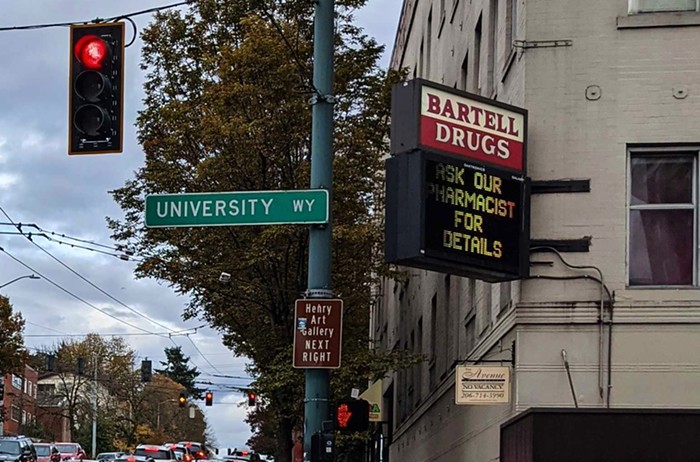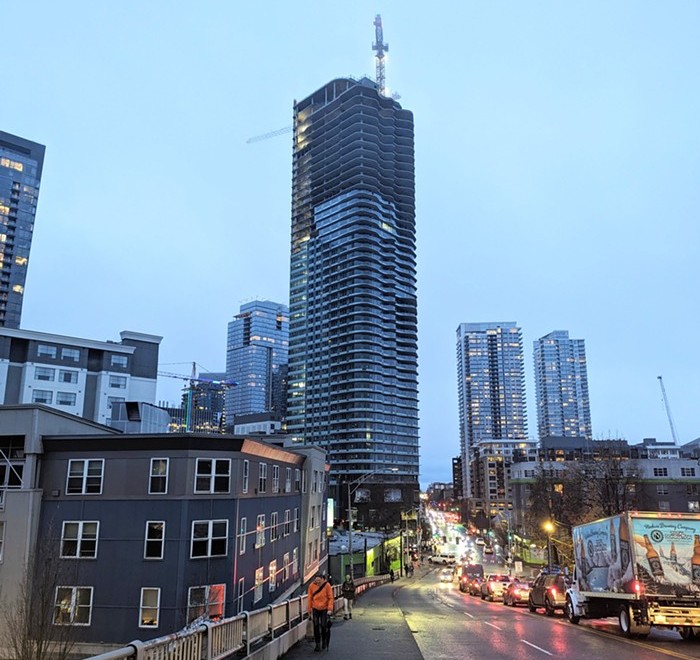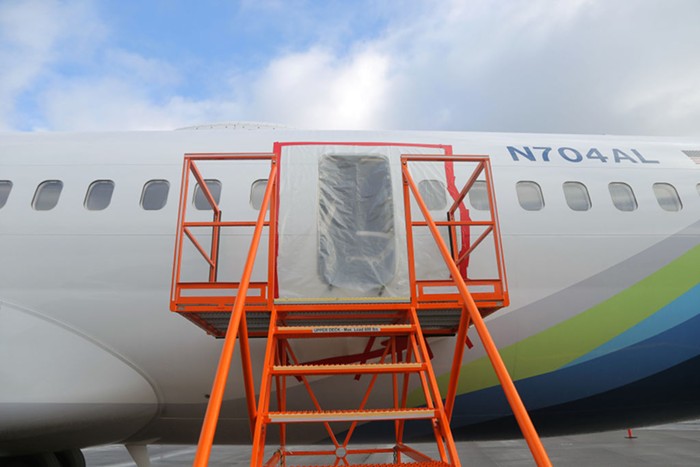
Bryan Corliss's analysis of Boeing's threat to leave the Puget Sound and concentrate the production of its 787 Dreamliner planes in South Carolina gets things mostly wrong.
This fact is surprising because Corliss writes for Leeham News and Analysis, a blog that covers "key developments in aerospace, principally of the 'Big Four' OEMs – Airbus, Boeing, Bombardier and Embraer." You would, therefore, expect Corliss to have a better picture of the situation. He does, however, open his piece, "Pontifications: Boeing in Washington: Here We Go Again," by making the valid point that Boeing has a long history of threatening to pull the plug on the region and the state.
He begins making this point by apparently referencing a tune by The Smiths ("Stop me if you’ve heard this one..."), and then goes on to say:
In the past, Corliss claims, the governors would do everything possible to keep Boeing happy ("job-training, infrastructure improvement, regulatory streamlining, tax relief"), but this time around the state to too tied up with COVID-19-related problems to do the usual song and dance for Boeing's execs. Corliss thinks the solution for this bad state of affairs is to better fund a government office that does this singing and dancing 24/7. The head of this office must have the power that CEOs recognize and respect, and also answer directly to the governor. Do this, and Boeing will soon be all "top of the morning" to the Puget Sound.Pundits are saying Boeing is going to leave Puget Sound, leaving behind the hollow husk of a company doomed to wither and die on the vine.
Just like they did in 2003, in 2009, in 2013 and 2016.
Seattle-area political economist and author T.M. Sell, in fact, traces the company’s first threat to leave clear back to the 1920s, when company executives got into a fight with the Seattle City Council over building new roads to connect downtown with the airport we now call Boeing Field.
Boeing said it would pack up and move to southern California, if Seattle didn’t cooperate.
“Like rain in winter, this is a regular feature of the Puget Sound emotional landscape,” Sell opined back in 2009.
The problem with this analysis and its conclusion is it makes no historical sense.
On February 11, 1941, the German economist Rudolf Hilferding was murdered by Nazis. Just under a year before his death, he published an article called, "State Capitalism or Totalitarian State Economy." In this piece, we find a passage that will help us better understand why Boeing is likely to concentrate plane production in South Carolina: "History, this 'best of all Marxists,' has taught us differently."
What does this mean? History is a one-of-a-kind Marxist? It is simply this: The starting point of historical analysis is class conflict. A history of Boeing's threats to Seattle and its region, its departure to Chicago in 2001, and its opening of production facilities in South Carolina in 2009 make no sense whatsoever if seen from the perspective of an underfunded government office. The explanation that matters is to be found in a class-conflict perspective.
What Seattle is experiencing today has been experienced by former industrial cities, namely Detroit and Pittsburgh. The former primarily produced cars for the post-war middle-class that emerged after the US government made huge investments in the suburbs. The latter made steel for national consumption. My research for a soon-to-be-posted essay that has "What Detroit's Autonomous Zones Can Tell Us About Seattle and CHOP" as its point of departure, and that concerns Hamtramck, a city within the city of Detroit, led me to a superb work of historical analysis by Thomas J. Sugrue. It's called The Origins of the Urban Crisis: Race and Inequality in Postwar Detroit. Its key point is that the deindustrialization of Detroit did not begin in the 1970s, as many believe, but actually at the peak of the city's economic greatness, the second half of the 1940s.
At around this time, the Big Three (General Motors, Ford, Chrysler) began to relocate factories from the city to the suburbs and other states with cheaper labor and weaker unions.
Sugrue writes:
...Motown lost more than 300,000 auto industry jobs, beginning in the late 1940s. The process of deindustrialization that I describe in The Origins of the Urban Crisis occurred steadily and relentlessly, following a path that led to the suburbs, to the rural Midwest, to the Sunbelt, to Canada and Mexico, and also overseas, as car manufacturers and suppliers searched for cheap labor, low taxes, and lax regulations.The problem for executives at the Big Three was militant labor unions, one of which, UAW Local 600, had become so radical that it racially integrated its members. That was far enough.
There were (and still are) two weapons against union power: capital mobility and automation. The former leads to globalization, the latter to what many mistake as historical progress. But we are not really moving forward. We are going nowhere. We are on what the social theorist Moishe Postone describes as a "treadmill." Machines are only advanced because capital must constantly set back labor.
"Between 1950 and 1956," writes Sugrue, "124 manufacturing firms located on the green fields of Detroit’s suburbs; 55 of them had moved out of Detroit"; on top of that, Ford set up an “Automation Department” in 1947. Ford had to deal with UAW Local 600, which dominated its massive Ford River Rouge plant and was the "largest employer of blacks in the Detroit area." The solidarity of black and white workers is trouble enough, but black workers at this plant overwhelmingly supported the "left-wing caucus of the UAW." White workers tended to be more cautious. In the end, both black and white workers lost the struggle with the executives, and the city was plunged into a decline like no other. But there is hope in the "husk" (what's left) of Detroit (the subject of an essay I promise to finish in October).
A similar structure of events can be found in Pittsburgh, whose economic history is of great interest to me because all but one of the plays in August Wilson's American Century Cycle are set in the Hill District, which was to Pittsburgh what the Central District was to Seattle, a deeply rooted black neighborhood. The city's economic rise and decline is described in John Hinshaw's Steel and Steelworkers: Race and Class Struggle in Twentieth-Century, which is well-researched but does not have the richness and depth of Sugrue's book. As the title of Hinshaw's historical analysis makes clear, "class struggle" played the key role in transforming Pittsburgh from an industrial city to a post-industrial one. The steel plants moved to national and international places that had cheaper wages.
In the language of post-Keynesian economics, this practice is called "wage arbitrage." We call a move arbitrage if a speculator or entrepreneur takes advantage of prices that are far below normal or standard prices. Meaning, the speculator or entrepreneur is simply avoiding paying the actual value of something. The labor in "right-to-work" states like South Carolina is undervalued, and this is why Boeing opened plants in that state. Eventually, the value of labor there will rise to a position that's close to normal standards, and the American plane manufacturer will have to open a plant in, say, South Africa.
What history tells us is that Boeing has been in a long struggle with its workers. But because the company's kind of business is capital intensive, it could only move at a very slow pace. Car production can pull the plug on the city much faster than plane production can. This slowness has presented analysts of the industry with the illusion of Boeing's permanence, the illusion that its threats can easily be dismissed. It's too costly for the Chicago-based corporation to abandon so much physical and human capital. But Boeing is not a state-owned enterprise. It's a hardcore business, and all businesses want their profits to grow. As inhuman as this logic is, it really does come down to that, which is why explaining the current threat cycle by way of the state's inability to adequately stroke the "big — and often fragile – egos" of CEOs is nothing but bizarre. Any psychological explanation that excludes the profit motive is worthless.
So, Seattle finds itself where Pittsburgh was in the 1970s and Detroit in the 1960s. The city is about to lose a central part of its industrial base. Today, Pittsburgh, the "Steel City," has no steel plants at all. Its economy is directed at health care services, a tech sector, and higher education. Detroit is much more interesting than Pittsburgh because capital there is still relatively weak, and this has created the ideal condition for immigrants and artists. But Seattle is in a strange situation. It became much more than Pittsburgh (it's now second only to the Bay Area as a tech hub) while the foundation of its twenty-century economy, plane production, was still in place. But this is because the aeronautical industry is inherently much slower than those industries that once defined Detroit and Pittsburgh.
Seattle will finally become fully post-industrial in the third decade of the third millennium.

















